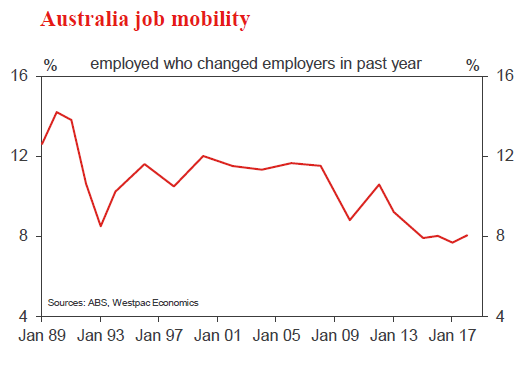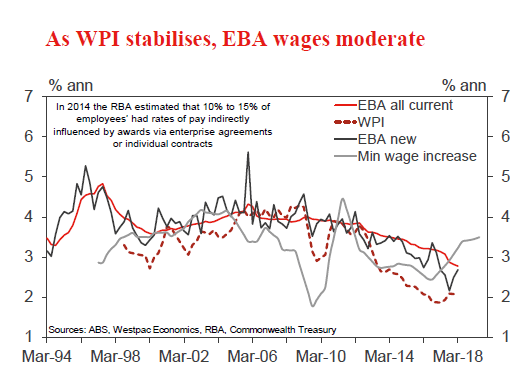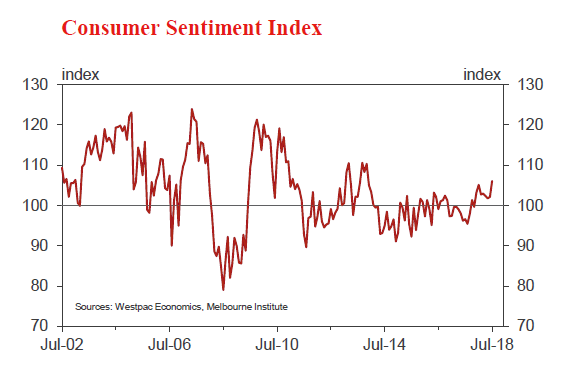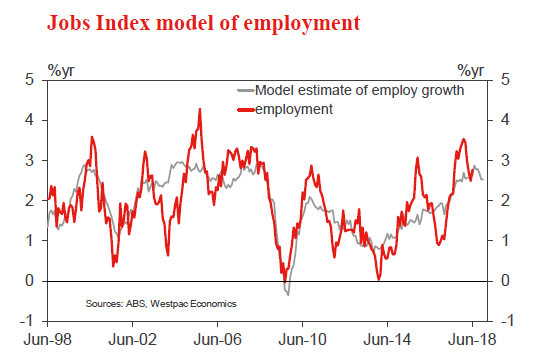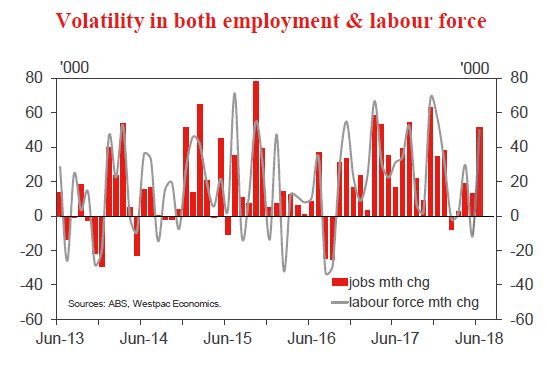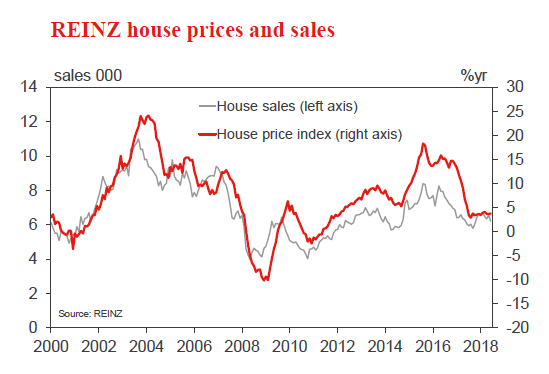Week beginning 13 August 2018
- RBA lowers inflation forecasts to reflect “one-off” effects.
- RBA: RBA Governor Lowe Semiannual Testimony, Assistant Governor Ellis speaks.
- Australia: Westpac-MI Consumer Sentiment, wage price index, employment, NAB business survey.
- NZ: REINZ house prices and sales.
- China: retail sales, fixed asset investment, industrial production.
- US: retail sales.
- Key economic & financial forecasts.
Information contained in this report current as at 10 August 2018.
RBA lowers inflation forecasts to reflect “one-off” effects
The Reserve Bank’s August Statement on Monetary Policy provides few surprises.
Of most interest in the Statement is the update in the Bank’s forecasts. In particular, this update includes another six months of forecasts to cover the whole of 2020.
The GDP growth rate forecasts through to end 2018 and end 2019 are unchanged from the May Statement at 3 ¼ per cent, while the 3 per cent forecast for growth through to June 2020 is extended to December 2020. The forecast slowdown between 2019 and 2020 is attributed to a flat contribution from LNG exports as production capacity peaks in 2019.
Growth to June 2018 is forecast at 3 per cent compared to 2 ¾ per cent in May. This forecast implies that the Bank is expecting the GDP print for the June quarter to be an optimistic 1.0%, following the 1.0% which was registered for the March quarter. In contrast, Westpac is expecting 0.6% for the June quarter growth rate.
The significant change from May comes with the inflation forecasts. Headline inflation to December 2018 has been revised down from 2 ¼ per cent to 1 ¾ per cent. Underlying inflation to December 2018 has been revised down from 2 per cent to 1 ¾ per cent. If those forecasts prove correct, then 2018 will be the fifth consecutive calendar year in which headline inflation has printed below the bottom of the 2-3% target band and the third consecutive year when underlying inflation has been the below the bottom of the band.
The Bank attributes this revision to changes in the September quarter, specifically for electricity, childcare costs and some education costs. They are claimed to be one-off and do not affect any subsequent quarters. Consequently, the forecasts for the year ending December 2019 are unchanged at 2 ¼ per cent (headline) and 2 per cent (underlying). The modest forecast lift in underlying inflation to 2 ¼ per cent to June 2020 which we saw in the May statement is extended to December 2020, with both headline and underlying forecast at 2 ¼ per cent.
There are no changes to the unemployment profile with the rate expected to be 5 ½ per cent in December 2018, 5 ¼ per cent in December 2019 and a projected fall from 5 ¼ per cent in June 2020 to 5 per cent in December 2020.
Commentary in the Statement around the growth and inflation outlook is largely unchanged from May. Consumer spending continues to be a source of “significant uncertainty” largely because of the outlook for household income growth. Key components here are wages growth and employment growth. The Bank does not provide specific forecasts for these variables, although employment growth is expected to be slightly above working age population growth of 1.6%.
Last week, I pointed out the deterioration in employment growth around the last two Federal election periods (2013 and 2016). With another election due by May next year, the risk of an unexpected slowdown in employment growth must be quite real although the Bank does not consider that prospect as part of the risks outlined in the Statement.
We are also not given the Bank’s forecasts for wages growth. The persistence of the unemployment rate being forecast to be above the full employment rate of 5 per cent would indicate little expected wage pressures. The Bank does identify uncertainty around the level of spare capacity in the labour market and seems to rely on its liaison program and evidence of tight conditions in construction and information technology. It is interesting to observe that the Government’s forecasts which were included in the May Federal Budget, and entailed a similar profile for the unemployment rate, expect wages growth of 3 ¼ per cent in 2019/20 and 3 ½ per cent in 2020/21. Prospects for such an optimistic outcome for wages growth seem remote, particularly as the Bank observes that current new enterprise bargaining agreements are lower than the average of those currently in existence.
The reason why the outlook for household incomes is so important is that with a very low savings rate; high debt levels; and falling house prices; it seems unlikely that household consumption can grow at a faster pace than incomes in the way we have seen in recent years.
These risks around a negative wealth effect are down played in the commentary. Various spokesmen for the Bank have indicated that while empirical estimates of the wealth effect are quite dated, the view is that the negative wealth effect in this upcoming cycle will be modest. The Statement notes that “there is no evidence that moderate house price declines have weighed on household consumption to date”. However, appropriately, some concern is raised around the consumption of highly indebted and or credit constrained households.
The Statement rightly acknowledges the recent solid growth in non-mining business investment which reached 10% over the year to the March quarter, largely driven by non-residential construction. While approvals in this sector are falling, the Bank’s expectation is that growth in machinery and equipment investment will pick up further over the forecast period. These investment decisions will be significantly influenced by expected demand and therefore the household consumption profile, making the debate around incomes important not only for consumption itself but also business investment. Those risks around political uncertainty are also relevant for business confidence and investment.
Public demand and exports remain the bright side of the growth outlook. We acknowledge that this boost is likely to continue and has spill-over effects to private sector investment. It is also true that resources export growth will be sustained although iron ore and coal volume growth will be relatively flat and compensated for by the ongoing boost in LNG at least out to end 2019.
Conclusion
The Bank’s approach, consistent with the May Statement, and many preceding statements, is to anticipate a gradual return to “normal conditions”. The spectre of the persistent underperformance of inflation over multiple years must be unnerving. Nevertheless this gradual return to normality remains the theme. From our perspective weak wages growth; a slowdown in employment growth; and potential negative wealth effects loom as more significant risks to these forecasts than the Bank appears to be prepared to accept at least in the Statement.
Westpac expects growth in the key policy year of 2019 to be only 2.5% compared to the 3 ¼ per cent anticipated by the RBA. We see larger risks around the household sector; negative wealth effects from the housing market; and share the RBA’s unease around the outlook for risks in China.
There is a clear sense that there is no particular urgency to change the policy stance and a forecast of 2 ¼ per cent underlying inflation and 5 per cent unemployment in 2020 certainly confirms that view.
We see no reason based on the Statement and the forecasts to change our view that the cash rate will remain on hold through the remainder of 2018 and 2019.
The week that was
A quiet week for data globally has drawn attention to central banking in the antipodes, as both the RBA (see essay) and RBNZ meet and updated guidance.
The tone of the RBNZ’s August communications was a stark contrast to the RBA’s optimism. For the past year, our NZ economics team has been warning that GDP growth would materially disappoint the bullish expectations of the RBNZ and NZ Treasury. As highlighted by NZ Chief Economist Dominick Stephens and more fully by the team, the RBNZ has now come to this realisation. Indeed, they have gone much further, projecting that the OCR will remain flat until September 2020 versus Westpac’s long-standing view that a first hike will come at end-2019. This abrupt shift by the RBNZ implies that risks to Westpac’s view are now skewed towards an even later start for rate hikes. In assessing these risks, a key barometer will be the Q2 GDP outcome.
This week the Sydney team has released a number of pieces of new research.
On the topic of the moment for Australian markets, shortterm wholesale funding, comes a real economy perspective. Specifically we assess how the abrupt deceleration in deposit growth is affecting these markets. Apparent to us is that Australia’s national income has gone through a protracted period of weakness. The consequence for corporates has been a need to carefully manage costs, particularly wage inflation. Deposit growth for corporates and households has therefore come under significant pressure. For household deposit growth, an additional negative as we look ahead is an end to the support that has come from strong price gains and high turnover in the housing market. The switch to principal & interest payments and rise in investor interest costs at a time of weak income growth creates yet more downside risk for deposit growth in the sector. The more that deposit growth underperforms credit, the greater the need for wholesale funding by the banks. This situation is likely to create sustained upward pressure on short-term wholesale funding rates into 2019, absent an increase in the supply of funds to this market.
Contained in our August Market Outlook are a number of other pieces of note. Firstly on inflation, we highlight that headline inflation is likely to move below the bottom of the RBA’s 2–3% inflation target band as electricity prices ease from elevated levels, and in the absence of any up and coming inflation pressures. This situation is expected to persist through 2019, with core inflation circa 2.0%yr forecast. Non-mining infrastructure investment is also in the spotlight in this edition. Spearheaded by public transport projects and private electricity generation, activity in this sector has directly added 0.75ppts to activity over the past 12 months. Importantly, supported by strong population growth and given a long period of under investment, this upswing has a lot further to run.
On the global scene, the August Market Outlook also highlights the strength of the US economy, which is set to justify four hikes by the FOMC to June 2019, but equally the risks thereafter. Despite very strong employment growth and a much-improved financial position, US consumers are hesitant to spend. Indeed, in 2018-to-date, they have actually throttled back on discretionary consumption and reduced housing investment. Also a clear risk to aggregate growth is business investment. So far trade tensions have offset the would-havebeen benefit of President Trump’s stimulus. But, if uncertainty persists, then investment could become an outright negative for the US economy.
Finally on China, Westpac Economics and Strategy have released an update to our 2018 and 2019 view for China, covering the real economy, policy and financial markets. We started this year with a sub-consensus view that growth would slow materially, to 6.3% in 2018 and 6.1% in 2019. Based on the 6-month annualised pace to June of 6.4%, our beginning of the year forecast looks to be on the mark. Weak investment by State Owned Enterprises and local government authorities has been key to this outcome, coming as a result of a government mandated wholesale change in credit supply and authorities’ related pursuit of high-quality growth and long-term prosperity. Amid growing trade tensions, authorities are starting to take a more active approach to policy to make sure that the deceleration in activity does not go too far. Note though this stimulus’ marginal nature. Hence we remain comfortable with a further deceleration to 6.1%yr in 2019.
If trade tensions intensify, a sub-6.0%yr growth pace could even be seen in 2019 absent additional fiscal support. On trade tensions, this week China implemented 25% tariffs on $16bn of US goods effective August 23, matching the scale of 2nd tranche of tariffs imposed by the US. China had flagged their response in advance, but removed crude oil from the original list of 114 products and consequently had to expand the final list to 333 products including coal, medical and steel products.
Chart of the week: Australia job mobility
The annual job mobility data was released this week and continues to point to low mobility. The chart to the right shows the share of employed who switched employers in a given year.
The same series was used in a Governor Lowe speech in 2017. Back then, he had this to say: “One related aspect of the current labour market is a decline in job mobility. Data published by the ABS suggest that the share of employed people changing employers is around the lowest in recent decades. It is likely that in an environment of less job security, fewer people are inclined to switch employers. There is also a demand-side effect, with fewer firms attempting to attract workers from other firms. This is consistent with subdued wage growth.”
Since then we have received the 2017 and 2018 updates which continue to show mobility around its lows. It would appear that high vacancies and reportedly high difficulty finding skilled workers has not seen employers bid for already employed labour.
New Zealand: week ahead & data wrap
Snap back to reality
As expected, the Reserve Bank repeated its line that the OCR will stay low for an extended period and that the next move could be up or down. However, the RBNZ’s interest rate projections and some subsequent comments have made clear the extent to which the ‘down’ scenario is a real prospect. We’re taking seriously the possibility of a rate cut within the next year, and we think that financial markets should too. However, we expect that some better-than-expected economic data will stay the RBNZ’s hand in the near term.
The August Monetary Policy Statement shifted broadly in the direction that we expected. We were saying at the start of this year that the RBNZ’s growth forecasts were too optimistic, and that as they came to realise this they would shift to a more dovish stance. This has now come to pass. At the time, financial markets and many forecasters were still predicting OCR hikes this year; the centre of gravity has now shifted towards a much later move.
However, the RBNZ has shifted its assessment even further than we expected. Their updated projection for the OCR is flat until September 2020, a year later than in the May MPS. From there, the next projected move is up, but at a very gradual pace.
At face value, the RBNZ’s assessment of the economy certainly wasn’t ringing alarm bells. The RBNZ is forecasting growth to accelerate again after a recent slowdown, supported by low interest rates, increased government spending and a rebound in export volumes. The Kiwibuild programme will help to boost construction activity, although the RBNZ has adopted the Treasury’s view that Kiwibuild will ramp up more slowly than previously expected. Above-potential growth would lead to greater capacity pressures and a lift in wage and price inflation.
The most substantial change compared to the May MPS was a cut to the GDP growth forecasts for the rest of this year, reflecting the softness in business confidence and other recent indicators. However, this slowdown was regarded as temporary.
The risk scenarios in the MPS were more revealing. On the one hand, the possibility of a faster than expected pickup in inflation would ultimately require higher interest rates than otherwise. But even then it wouldn’t require a sharp response, as it would actually serve to get the RBNZ closer to its inflation target.
On the other hand, the downside scenario considered a slower pickup in GDP growth (though still accelerating from its recent pace). A slower than expected pickup in activity could see the RBNZ fall short on both its inflation and employment goals, and would warrant a substantially lower OCR.
The potential for a cut was reinforced in a later interview with the RBNZ’s Assistant Governor McDermott, who commented that “we’ve been pushed nearer to that trigger point”. McDermott went on to highlight that the RBNZ will need to see a lift in GDP growth in the September quarter (when increased fiscal stimulus should start to come through) to be convinced that it is on the right track.
These comments suggest that the risk of an OCR cut is real, but not imminent. September quarter GDP isn’t published until late December, though there will be some indicators out in time for the November MPS.
Moreover, our view is that the RBNZ won’t have to wait that long for some reassurance. The RBNZ expects June quarter GDP to rise by 0.5%; the information that we have to date suggests an outturn closer to 1%. Of course, quarterly GDP outturns can be volatile – we think that the 0.5% rise in the March quarter probably understated the underlying pace of growth, and that the June quarter will almost certainly overstate the case. But there are some genuine positives in there as well. For instance, last week’s labour market surveys showed a surprisingly strong lift in employment and hours worked in the June quarter.
Perhaps less significantly, we’re also expecting the next inflation print to top the RBNZ’s forecast. The RBNZ is expecting a 0.4% rise in September quarter prices, with a particularly soft result for tradable goods prices. We’re expecting a 0.7% rise for the quarter, with fuel prices set to make another sizeable contribution. However, this is the kind of inflation surprise that the RBNZ has scope to look through.
We should emphasise that not all of the upcoming economic news is going to be more favourable. The housing market is likely to remain subdued this year, as various Government policies aimed at dampening housing market speculation come into effect. That’s also likely to weigh on growth in household spending.
In addition, we expect the recent slowdown in growth to filter through to the labour market with a lag. That implies the uptick in the unemployment rate in the June quarter could run further in the near term, before the effects of fiscal stimulus push it lower again next year. It’s not clear to what extent the RBNZ would be willing to tolerate a move in unemployment in the wrong direction, so we will be watching vigilantly for any labour market developments that could trigger a rate cut next year.
Financial markets have now removed any pricing for OCR hikes, and are now giving a 20% chance of a cut in the next year. We think that that shift has been appropriate, and is likely to go even further in the coming weeks. That in turn implies lower borrowing rates and a lower exchange rate, which would serve the RBNZ’s purposes.
Data Previews
Aus Q2 Wage Price Index – %qtr
- Aug 15, Last: 0.5%, WBC f/c: 0.6%
- Mkt f/c: 0.6%, Range: 0.5% to 0.8%
There has been some removal of excess slack in the labour market as well as the annual boost from the lifting of the minimum wage. And yet, we are still to observe a meaningful pickup in wage inflation. Total hourly wages ex bonuses gained 0.5% in Q1, again slightly less than market expectations of 0.6% holding the annual rate at 2.1%yr.
In Q1, private sector wages grew 0.5% holding the annual rate at 1.9%yr. Public sector wages grew 0.5% with the gains coming from education (0.8%) and public administration (0.5%). Public sector wage inflation has eased back to 2.3%yr from 2.4%yr which is on par with the 2016 record low of 2.3%yr.
The boost to the minimum wage last year helped to put a floor under wage inflation in 2016/2017 but it did not boost over wage inflation. This year the minimum wage was lifted by 3.5% to $18.29 per hour but this does not apply to July 1. As such we are forecasting a modest 0.6% rise but are cautious that an undershoot is again possible.
Aus Aug Westpac-MI Consumer Sentiment
- Aug 15, Last: 106.1
The consumer mood showed a clear improvement in July, the Index rising 3.9% to 106.1, the most positive since November 2013. That said, the overall level of sentiment is still not strong – the index averaged 108.3 over the ten years prior to the GFC with peaks well above the 110 mark. Much of the improvement over the last year reflects a more balanced growth profile across states.
The August survey is in the field from August 6-11. Factors that may influence this month include: the RBA’s decision to leave official rates on hold, recent comments emphasising that any move is still a long way off; continued slippage in dwelling prices. Financial markets have been relatively steady, the ASX up marginally since the last survey and the AUD down slightly. Offshore, global trade tensions have again been to the fore.
Aus Jul Labour Force Survey – Employment ‘000
- Aug 16, Last: 51.9k., WBC f/c: –5.0k
- Mkt f/c: 15k, Range: -22k to 30k
Australian employment increased by 51k in June beating the market consensus expectation of +16.5k and Westpac’s +17k. With full-time contributing most of the gain, +41k, part-time rose +10k while hours worked increased by 0.6% rounding out a positive June employment result. Yet, the six month annualised pace is down to 1.9% from a peak of 4.3% in August 2017, though June’s result means the three month average is 28k per month.
Employment in the business surveys softened in the last few months, something we are watching closely. Of note the June survey was associated with a strong rise in employment & participation. The ABS notes that in July, the outgoing rotation group has higher employment and participation ratios than the average for the whole sample. If the incoming sample is more like the average, then it will drive both a softer employment and participation print hence we see the risk for a negative print. Our –5k forecast will see the three month average fall to 19.8k.
Aus Jul Labour Force Survey – Unemployment %
- Aug 16, Last: 5.4%, WBC f/c: 5.4%
- Mkt f/c: 5.4%, Range: 5.3% to 5.5%
The Australian unemployment rate held at 5.4% as the participation rate reversed last month’s decline to lift to 65.7% from 65.5%. In part, this highlights the responsiveness of labour supply to stronger employment that we have been seeing over the past few years. As such, the unemployment rate has been sticky around 5 ½ per cent.
But we also note above that some of the monthly volatility can be driven by sample volatility. We suspect some of the rise in both employment and the labour force in the June survey was due to the sample rolling in having a much higher attachment to the labour force. If the sample rolling in July is more like the sample average then we will see not only a softer employment print but also softer participation.
This is why, despite our forecast –5k for employment, we see the unemployment rate flat at 5.4%.
NZ Jul REINZ house sales and prices
- Due the week beginning Aug 13,
- Sales, Last: -5.1%. Prices, Last: 3.8%yr
The housing market has weakened over the past few months. Prices are falling in Auckland and Canterbury, and price growth has weakened elsewhere. June data was particularly weak, with a 5.1% drop in nationwide sales.
The slowdown in the housing market comes against a backdrop of significant policy changes targeting housing affordability and supply. We expect that these measures will result in further weakness in July.
Looking further ahead, restrictions on foreign buyers are likely to reinforce the other factors weighing on house price growth, although falling fixed interest rates might be a partial countervailing force.




